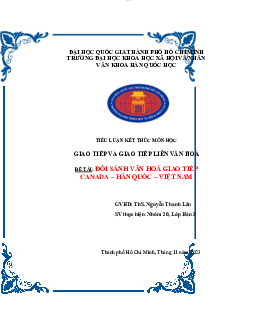









Preview text:
1. Individualist - Collectivist Individualist Collectivist
● The individual > The group
● The group > The individual
● Every citizen has certain rights that cannot be
● The individual is a part of the community. disregarded.
● The survival and success of the group ensures
● Values: Personal freedom, independence and
the well-being of the individual. self-reliance
● Values: Harmony, interdependence, and
Ex: Freedom of speech and the right to “bear arms”
achievement of group goals.
Care more about personal achievement and Ex: The Japanese word ‘Shinyuu’ (‘best friend’ ~ ➡ recognition
making decisions around the well-being of their friends) ●
● Little distance between group members
More distance from others -> Care of oneself
and their immediate family only
● In Egypt, it’s normal to greet someone every
● Usually associated with low context culture
ve minutes while walking down the street. ->
NO shared common background
● Usually associated with high context culture explicit communication ➡ Germany: Mexico:
● Parent-children relationship > With aunts
● Relationships have grown over years of and uncles
communication and a shared understanding
● Self-motivation and personal identity of expectations.
● Direct communication style 1 lOMoAR cPSD| 40749825
2. Universalist - Particularist.
People in all cultures struggle with how to balance personal responsibilities to family, close friends,
and colleagues (your ingroup), on the other hand, and responsibilities to society in general on other. Universalist Particularist
● Searches for what is systematic
● How you behave in a given situation
● Tries to impose the rules, laws, and norms
depends on the circumstances on all of its members
● Rules are exible; ➡ What is right in one
● There are certain absolute principles and rules
situation may not be right in another.
that should be universally applied, regardless
● There are always exceptions for certain people
of circumstances or situations.
● You treat family, friends and your ingroups
● Rules are rules; what is right is always the best you can. right.
● To be fair = treat every as unique.
● You should try to apply the same rules to
● People in particularistic cultures tend to
everyone in the same situations
orientate themselves towards other people and
● No exceptions (exceptions lead to corruption)
relationships rather than the rules. Fairness ➡
● The relationship between universalism with
● Particularism in Korea
low- context culture and direct
+ Koreans value relationships and trust communication: over the rules.
+ formal documents that are clear and
+ They believe circumstances dictate literal the rules they follow;
+ Love things that are planned and
+ their responses depend on the detailed
situation or who is involved.
+ Focus on the similarities among
● Particularism in Mexico: “Does your friend members of a community
have the right to expect you to protect him?”
● Universalism in Germany + Americans: say NO + Germans love rules.
+ Mexicans: say YES ➡ the social
+ tend not to share their emotions.
relationships they have with that
+ Germans are rarely ready for
friend obliges them to help that person spontaneity. 2 lOMoAR cPSD| 40749825
No culture will be exclusively universalist and particularist - all cultures have elements
of both - but cultures do tend to be more one than other.
3. Monochronic - Polychronic Monochronic Polychronic
● Attend events sequentially.
● Attend multiple events
● Doing one thing at a time simultaneously.
● Time is valuable
● Doing several things at the same time
● Schedules > satisfaction, good work,
● Time is less valuable and relationships.
● Relationships > schedules ● Time can be killed
● “natural rhythms,” and to “the earth”
● View of time can be stressful
and “the seasons” => occur
● Give rst priority to work.
spontaneously, sporadically, or concurrently
● Life is unpredictable.
● Advantage: sense of order
● Advantage: exibility and
● Disadvantage: inexibility and adaptability
inability to accommodate new
● Disadvantage: overloading, spreading information oneself too thin 3 lOMoAR cPSD| 40749825
4. Internal - External Internal External
● The locus of control is largely internal.
● The locus of control is largely external.
● The things that have happened are largely
● Many things in life must be accepted.
controlled by themselves.
● Some problems are beyond their ability to
● A few things can not be changed. control and address.
● Nothing is beyond one’s grasp.
● One’s success is a combination of their
● Everything depends on individual
e§ort and good fortune. motivation and e§ort.
● Life is in large part what happens to you.
● Their success is their personal achievement.
● Fate plays a major role.
● Life is what you do.
● Fate has little or no importance.
→ These represent more activist cultures. → These represent more fatalist cultures.
Countries have internal locus of control Countries have external locus of control In Germany:
● Strong work ethic
● Eastern Europe
● Education and training system ● China ● India ● Economy
● The Middle East 4 lOMoAR cPSD| 40749825 Locus of control
Both of the two poles have their own good sides → should not judge any culture. Document. 5 lOMoAR cPSD| 40749825 Hofstede's Framework
1. Power-Distance Index
The power distance index describes the extent to which the less powerful members of an organization or institution
— such as a family — accept and expect that power is distributed unequally.
Although there is a certain degree of inequality in all societies, Hofstede notes that
there is relatively more equality in some societies than in others
High power distance society:
Low power distance:
● Individuals accept hierarchies where
● Individuals seek to have an equal
everyone has a place in a ranking
distribution of power. The implication
without the need for justication.
of this is that cultures endorse and expect
● Family: Parents may expect children to
relations that are more consultative,
democratic, or egalitarian.
obey without questioning their
authority. Those of higher status may
● Family: There tends to be more equality
also regularly experience obvious
between parents and children, with parents
displays of subordination and respect
more likely to accept it if children argue from subordinates.
or “talk back” to authority.
● Superiors and subordinates are unlikely
● In low power distance index workplaces,
to see each other as equals in the
employers and managers are more likely to
workplace, and employees assume that
ask employees for input; in fact, those at
higher-ups will make decisions
the lower ends of the hierarchy expect
without asking them for input.
to be asked for their input (Hofstede, 1980). 6 lOMoAR cPSD| 40749825
Characteristics of High Power Distance in Vietnam ●
Respect for authorities and elders is crucial in Vietnamese culture ●
Younger people show deference to older people by using honoric titles ●
Centralization of decision making - high level managers make most decisions with
little input from lower levels ●
Large gaps in status, prestige and wealth are considered normal ●
Less powerful people expect to be told what to do by more powerful people
2. Collectivism vs. Individualism
Individualism and collectivism, respectively, refer to the integration 1 of individuals into groups.
Individualistic societies Collectivist societies
● stress achievement and individual rights
● Placing greater importance on the goals and
● focusing on the needs of oneself and one’s
well-being of the group immediate family.
● Person’s self-image in this category being ● A person’s self
more similar to a “We.”
-image in this category is dened as “I.”
● Tend to emphasize relationships and loyalty
more than those from individualistic cultures.
● Belong to fewer groups but are dened more
by their membership in them. 7 lOMoAR cPSD| 40749825
3. Uncertainty Avoidance Index
The uncertainty avoidance dimension of Hofstede’s cultural dimensions addresses a
society’s tolerance (mức độ chịu đựng) for uncertainty and ambiguity (sự mơ hồ).
This dimension reects the extent to which members of a society attempt to cope with their
anxiety by minimizing uncertainty. In its most simplied form, uncertainty avoidance refers
to how threatening change is to a culture (Hofstede, 1980).
High uncertainty avoidance cultures
Low uncertainty avoidance
● A low tolerance for uncertainty, ambiguity,
● Accept and feel comfortable in unstructured and risk-taking.
situations or changeable environments
● Both the institutions and individuals within
● Try to have as few rules as possible.
these societies seek to minimize the unknown
● Tend to be more tolerant of change.
through strict rules, regulations, and so forth.
● The unknown is more openly accepted, and
● People in these cultures also tend to be more
less strict rules and regulations may ensue. emotional.
For example, a student may be more accepting of a teacher saying they do not know the answer to a
question in a low uncertainty avoidance culture than in a high uncertainty avoidance one (Hofstede, 1980). 8 lOMoAR cPSD| 40749825
4. Femininity vs. Masculinity
Femininity vs. masculinity is also known as gender role dierentiation. This dimension
looks at how much a society values traditional masculine and feminine roles. A masculine society A femininity society
● Assertiveness, courage, strength, and
● Cooperation, nurturing, and quality of competition life
● Feminine gender roles are less important.
● Traditionally feminine gender roles are
more important in that society
For example, a country with a high femininity score is likely to have better maternity
leave policies and more aordable child care.
Meanwhile, a country with a low femininity score is likely to have more women in
leadership positions and higher rates of female entrepreneurship (Hofstede, 1980). 9 lOMoAR cPSD| 40749825
5. Short-Term vs. Long-Term Orientation
The long-term and short-term orientation dimension refers to the degree to which cultures encourage
delaying gratification or the material, social, and emotional needs of their members (Hofstede, 1980). Long-term orientation Short-term orientation
● Delay short-term success in favor of success in
● Indicates a focus on the near future. the long term.
● Involves delivering short-term success or
● Emphasize traits such as persistence, gratication.
perseverance, thrift, saving, long-term growth,
● Places a stronger emphasis on the present than
and the capacity for adaptation. the future.
● The end result of this is an emphasis on quick
results and respect for tradition.
● Unrestrained spending, often in response to
social or ecological pressure 10 lOMoAR cPSD| 40749825
6. Restraint vs. Indulgence
The restraint and indulgence dimension considers the extent and tendency of a society to fulll
its desires. That is to say, this dimension is a measure of societal impulse and desire control. Restraint Indulgence
● Tend to suppress the gratication of needs
● Indicate that society allows relatively free
and regulate them through social norms.
gratication and high levels of bon de vivre.
For example, in a highly indulgent society, people may tend to spend more money on
luxuries and enjoy more freedom when it comes to leisure time activities. In a restrained
society, people are more likely to save money and focus on practical needs (Hofstede, 2011). 11




